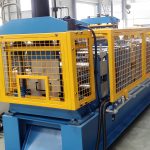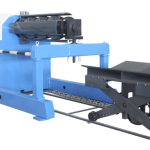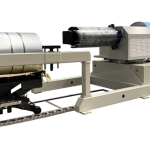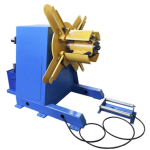Q1: What is the scientific basis for the incremental bending process in cold roll forming, and how does it prevent catastrophic material failure compared to single-step bending?
The scientific basis for the incremental bending process in cold roll forming lies fundamentally in the principles of plasticity, work hardening, and strain energy distribution. This phased approach is a direct engineering response to the limitations of material ductility and the complex stress states induced during metal deformation, ensuring the production of long, complex profiles without catastrophic failure.
1. The Physics of Incremental Deformation
Roll forming works by passing a metal strip, typically coiled steel, through a series of consecutive roll stands, or passes. Each stand contributes a small, precisely calculated amount of plastic deformation (permanent change in shape) to the strip.
A. Controlled Plastic Strain
In any metal forming process, deformation occurs when the applied stress ($\sigma$) exceeds the yield strength ($\sigma_y$) of the material, causing the material to enter the plastic region of the stress-strain curve. If the metal is bent too severely in one step, the local strain rate in the highly stressed areas (the outer surface of the bend radius) can exceed the material’s uniform elongation limit ($e_u$) and quickly reach the fracture strain ($\epsilon_f$).
The incremental approach ensures that:
Where $\epsilon_{\text{total}}$ is the final strain required, $N$ is the number of passes, and $\Delta \epsilon_i$ is the strain contributed by each pass $i$. By keeping each $\Delta \epsilon_i$ small, the process controls the buildup of strain, allowing the material structure to adjust and redistribute internal stresses gradually.
B. Managing Bending Moments and Neutral Axis Shift
In roll forming, the material is subjected to a pure bending moment (M). For a strip of thickness $t$ and width $w$, the maximum bending stress ($\sigma_{\text{max}}$) occurs at the extreme fibers. If the bending is too aggressive (high $\Delta \epsilon_i$), the stress gradient across the thickness becomes too steep, leading to:
- High Tensile Strain: On the outer surface, which can cause micro-cracking, tearing, or orange-peel effect.
- Excessive Compressive Strain: On the inner surface, which can lead to localized buckling or wrinkling (a common defect in deep-profile forming).
Incremental bending smooths the transition of the neutral axis (the plane within the cross-section that experiences zero longitudinal strain), minimizing longitudinal strain accumulation per stand.
2. The Role of Work Hardening
Cold forming processes, by definition, occur below the material’s recrystallization temperature, which results in work hardening (or strain hardening). Work hardening increases the material’s yield strength ($\sigma_y$) as it is deformed, according to the power law:
Where $K$ is the strength coefficient and $n$ is the strain hardening exponent.
A. Controlled Strength Enhancement
If a profile is formed in one aggressive pass, the localized work hardening can be excessive, making the material brittle and highly susceptible to failure in that zone.
Incremental forming distributes the total required work hardening across the $N$ passes. This gradual hardening:
- Increases Structural Integrity: The finished product is stronger (higher yield strength) and more rigid than the original coil material, a primary advantage of cold forming.
- Maintains Ductility: By preventing instantaneous high strain, enough residual ductility remains to complete the final bends without fracture, utilizing the work-hardened state to resist subsequent deformation.
3. Preventing Catastrophic Failure (Tearing and Wrinkling)
Catastrophic failure in metal forming is often predicted using the Forming Limit Diagram (FLD), which plots the major principal strain ($\epsilon_1$) against the minor principal strain ($\epsilon_2$) to define a boundary (the Forming Limit Curve, FLC) above which failure occurs.
A. Tearing Prevention (Tensile Failure)
Tearing (tensile failure) occurs when the tensile strain is too high, often at the outer edge of a bend. The incremental process keeps the local strain path well below the FLC by:
- Strain Relief: Each pass slightly relieves the built-up internal tension, allowing the material to flow into the new shape.
- Tooling Contact: The rolls provide continuous lateral and compressive support, suppressing the tendency of the material to neck or fracture under tension.
B. Wrinkling/Buckling Prevention (Compressive Failure)
Wrinkling (compressive failure) often occurs on the inner radius or on free edges due to excessive longitudinal compression. In roll forming, this is mitigated by:
- Flower Pattern Design: The design of the roll profiles (flower pattern) ensures that free material edges are bent late in the sequence, and the forming pressure is carefully balanced to apply just enough tension to pull the material flat (preventing wrinkling) but not so much as to cause tearing.
- Side Rolls and Idlers: Auxiliary tooling (like side rolls) is often used to apply lateral constraint, which stabilizes the web and flanges, preventing localized buckling due to compressive stresses.
In conclusion, the incremental bending in cold roll forming is a highly sophisticated engineering process governed by continuum mechanics and material science. It transforms a complex, failure-prone single-step deformation into a series of predictable, manageable bending moments, strategically leveraging work hardening to enhance the final product’s strength while carefully avoiding the critical fracture limits of the material.









